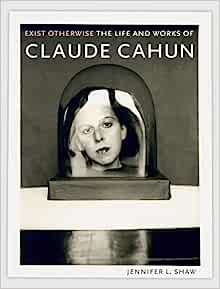Mary Fletcher
 Claude Cahun’s art was known to me via a handful of photos and I knew little of her life before reading this account.
Claude Cahun’s art was known to me via a handful of photos and I knew little of her life before reading this account.
It’s a very beautifully designed book. There are four chronological chapters and an appendix of a few translated documents and a useful index.
Claude Cahun chose her name and from an early age was concerned with her own image and identity as a lesbian, inspired by male queer writers and the idea of an Ancient Greek utopia.
Her relationship with her mother was fraught and as her father was Jewish she suffered from anti semitism. She met her lifelong partner Suzanne Moore when they were both teenagers.
Claude had enough money not to need a job and moved in avant garde arty circles in Paris. She wrote the stories of various heroines such as Eve, Sappho, Judith and others, reimagining them from. a modern viewpoint. In self portrait photos made with her partner she played with masquerade doll like roles using androgyny and theatricality.
Jennifer Shaw discusses the possible sexual symbolism in Cahun’s montage images.
During the thirties Claude met Breton and other surrealists, made playful photographs and joined in turn various political groups of artists to combat fascism. She veered towards Trotsky’s idea of individual freedom for artists to express their inner world and in 1939 signed a manifesto that declared ‘there will be no freedom until everyone is free’. Aragon criticised her as essentially bourgeois in her individuality.
Her strange constructions were photographed as illustrations for a disturbing children’s fairytale book by Lise Deharme.
After the wealth of references and names of well known surrealists that Claude knew and enough details of her work to establish that she should be part of the canon of art history, the last chapter in which she is living in occupied Jersey with her partner is by far the most fascinating.
Claude and Suzanne agreed to devote themselves to placing anti war propaganda in a variety of inventive ways in their environment. It was written as if by a disillusioned German soldier, aided by Suzanne’s fluent German language and the two of them spent a lot of time on this and put themselves at great risk.
Eventually they were arrested, sentenced to death and put in solitary confinement, saved from deportation by the progress the allies were making towards winning the war. Claude called this work ‘militant surrealist action’. She despised the Jersey population’s failure to resist the nazi occupation and hoped to affect the behaviour of those German occupiers who could be influenced against Hitler.
Their prison experiences and subsequent release are remarkable and could make a wonderful film.
Unfortunately Claude’s health was broken and she died, 1953, before their plans to return to liberated Paris were carried out. Suzanne Moore remained in Jersey, killing herself in 1972.
The wartime story is such a humdinger – I found it very moving and amazing and highly recommend the book for that well researched and fluently written account.
Exist Otherwise The Life and Works of Claude Cahun
by Jennifer L Shaw 2017.
Paperback ISBN. 978-1789147001. Reaktion Books 2023
